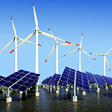- Home >
- Our Actions >
- Ambassador report
5
Comments
Technologies that save the environment |
|---|
|
by Arushi Madan | 29-04-2016 04:00
|
|
Autonomous Transportation His Highness Sheikh Mohammed Bin Rashid Al Maktoum, Vice President and Prime Minister of the UAE and Ruler of Dubai, launched this week the Dubai Autonomous Transportation Strategy, which aims to transform 25 per cent of the total transportation in Dubai to autonomous mode by 2030, saving Dhs22 billion(6 Billion USD) in annual economic costs.
UAE has demonstrated by it's solar impulse that it is feasible to fly many days, many nights on solar energy. The plane's ideal flight speed is about 28 mph, though that can double during the day when the sun's rays are strongest. The carbon-fibre aircraft weighs over 5,000 pounds, about as much as a midsize truck. The plane's wings, which stretch wider than those of a Boeing 747, are equipped with 17,000 solar cells that power propellers and charge batteries. The plane runs on stored energy at night. The project, which is estimated to cost more than $100 million, began in 2002 to highlight the importance of renewable energy and the spirit of innovation.
Solar-powered air travel is not yet commercially practical, given the slow travel time, weather and weight constraints of the aircraft.
Innovation and pioneering must continue for better quality of life, for clean technologies, for renewable energy. This is where the pioneers can really express themselves and be successful 3D Printed buildings You've heard of bricks and mortar, how about bricks and toner? That might be the future of construction in Dubai, with the unveiling of a plan (this week) to have a quarter of city's new buildings built using 3D printers by 2030. That is the bold aim of HH Sheikh Mohammed bin Rashid Al Maktoum, Vice President and Prime Minister of the UAE and Ruler of Dubai, who insists the printing process will make construction faster,cheaper and save natural resources.According to him, the future will depend on 3D printing technologies in all aspects of our life, starting from houses we live in, the streets we use, the cars we drive, the clothes we wear and the food we eat. The initiative could lead to a fall in construction costs of 50 to 70 per cent and a drop in labour costs of 50 to 80 per cent. This technology will restructure economies and labour markets as the use of unskilled labour will come down. It will also redefine productivity because the time needed for 3D printing of buildings and products will be 10 per cent of the time taken in traditional techniques. 3D printing can involve the use of wide range of materials. It usually involves a robotic arm using thousands of tiny layers to gradually build up a larger solid object, from the bottom up, layer by layer. 3D printing in building usually requires no steel, therefore lowering the costs as well as reducing the number of people required to build it.So it might even help reduce property and rental costs, because of low construction costs for contractors and developers. 3D printing is basically less work in less time and with fewer workers. Also, it's more accurate in terms of the shapes and sizes of each room. Sometimes, when a contractor is not very experienced, the measurements may not be very accurate – but 3D printing gives precision. Drones Drones area being used in UAE to inspect solar panels, check infestations in date plantations and look for environmental violations at quarry sites, safeguard the creek etc. Drones have enormous potential to combat environmental change. The ReefRover drone allows researchers to better understand and protect the UAE?s coral reef systems.
The "planting drone" designed by UK-based BioCarbon Engineering is able to plant 36,000 trees a day - meaning that 50 drones, operated by teams of two people each, could potentially plant a billion trees a year to combat deforestation. Peizoelectricity (harnessing wasted energy) Students at the American University of Sharjah developed a power generation system using piezoelectric technology to produce sustainable electricity by harnessing mechanical energy, acoustic noise and ultrasonic waves. By capturing mechanical energy, noise and sound vibrations from situations where noise would otherwise be wasted, the students proposed to capture this energy and convert it to electricity by using piezoelectric technology. Piezoelectric technology is a specific kind of material that generates voltage upon the application of pressure from movement or vibrations. The piezoelectric compound is harnessed by extracting material from natural properties like silicone from sand or using crystal properties mixed with components like titanium to capture vibrations produced from movement. Look into places where a lot of mechanical energy or noise is wasted like footsteps on a pavement or noise in football stadiums.All this wasted energy can be harvested using this technology.
Way to harness energy from cars is to place piezoelectric devices in speed bumps on the roads. Whenever a car goes over the bump it generates vibrations and from that vibration , the energy is stored. Once the energy accumulates it could light the street because the movement is there anyway so this way we save energy as well as the electric grid. Another application of the piezoelectric technology, could be to place a small device in people's shoes to capture the energy they create while walking. Walking generates energy so if it's stored, we can use it to charge a small electric device like a mobile phone, because we are moving anyway. This way energy developed is renewable and sustainable energy and such a power generation device could also be used to enhance the quality of life for people living in poverty. Peizoelectricity has immense potential and is one of my favourite topics to study, explore and experiment. Sources The Gulf Today 7 Days Khaleej Times Photo credits : Khaleej Times
|
    
|
|
|










 Previous : Technologies that Saves the En...
Previous : Technologies that Saves the En...









5 Comments
Hello arushi
I hope you are doing well
Great innovation
Thank you so much for report
Green cheers
Regards
Asmita Gaire
Posted 31-05-2020 11:15
Great article Arushi! All these technologies are revolutionary. However, they are mostly being used in commercial purposes such as production. The impacts on the environment would be maximized when they are solely devoted for the purpose of environment conservation. I hope this comes in the minds of our leaders ASAP.
Posted 01-05-2016 13:30
@ Heonjun: 3D printed parts produce zero waste, reduce transportation impacts, and are fully recyclable. 3D printing reduces labour costs as well. Reduction in Fossil Fuel Use From Shipping-is quite considerable. Thanks for going through my report.
Posted 01-05-2016 03:56
Wow thanks for such an elaborated report Arushi. When I read the part about autonomous technology and articial intelligence, I suddenly imagined it would be fantastic if there were robots that could move around by themselves and plant trees haha:-) I believe there are tremendous ways that technology can contribute to improving our lives and also the environment. Thanks for posting and have a great day!
Posted 30-04-2016 21:58
Thanks for posting Arushi. About the 3D printing thing, a house was already built using this technology in China. I didn't know it also produces environmental benefits though. But I wonder, doesn't the printing technology only speed up the building procedure not reduce the amount of resources needed..? probably i should dig in more. Thanks!
Posted 30-04-2016 19:17